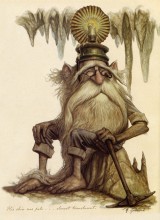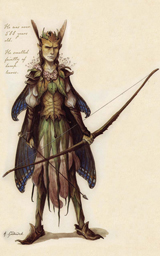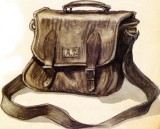Pie Corbett looks at how The Spiderwick Chronicles can provide a rich vein of inspiration for recounts and many more literacy lessons...
Jared Grace’s Diary: Monday 12th June
This morning Mallory, Simon and I met a Wood Elf while we were playing by the bridge.
Simon thought that it would be a good idea if we built a tree house, up in the trees, so we would have a place to hide if the goblins tried to attack us while we were too far away from the house. We were busy making the hide when the elf appeared. At first, the elf was furious but after we explained what we doing, he became quite friendly.
His name is Marengorm. When I first saw him, I thought that he was part of the branch because he was camouflaged with all sorts of leaves, strips of bark and seeds. Jared recognised him as a Wood Elf immediately because Arthur Spiderwick had made notes in his journal about a Wood Elf called Larengorm.
Marengorm told us that there were lots of elves in the woods and we should never dance with them or eat their food. He warned us not to go near mushroom rings or any place where there are trees in a circle. Apparently, elves can be rather tricky and should not be trusted.
Once we had finished the hide, Marengorm promised that he would make sure that it was protected from any trolls or goblins. We are hoping to meet him tomorrow but Mallory thinks we should not trust him.
Mallory Grace’s Diary: Tuesday 13th June
 Yesterday we met a Wood Elf which looked just like the one in Arthur Spiderwick’s book. Jared is right. Everywhere we go there are all sorts of creatures. I am not sure that we should trust Marengorm because Arthur says in his journal that elves often try to lure humans away. They are mischievous.
Yesterday we met a Wood Elf which looked just like the one in Arthur Spiderwick’s book. Jared is right. Everywhere we go there are all sorts of creatures. I am not sure that we should trust Marengorm because Arthur says in his journal that elves often try to lure humans away. They are mischievous.
However, on our way to the hide we had built, we made another discovery. As we were climbing over some rocks on the edge of the stream, we heard someone singing. We crouched down and crawled forwards. Sitting in a patch of sunlight was what looked like a rather small and very old man. He had a long beard, enormous ears and very bright eyes. On his head was a very strange looking hat which had a candle stump in the middle. He introduced himself as Garven. We checked in Arthur’s book and Garven is actually a Northern Quarry Dwarf.
Garven told us that he was enjoying the warm sunlight as he had been tunneling for many months. He lit a smelly pipe and sat there, chuckling to himself as he told us about how the dwarves built tunnels under the forest so that they can escape the trolls. They are great miners and have discovered gold, silver and many rare gemstones.
After a while, he showed us that he could shift shape. He turned himself into what looked like a rock… and then, a moment later, he crouched into the shape of what looked like a tree stump. Laughing out loud, he told us that we had walked past him many times over the last few days.
He gave me a beautiful, silver ring. Instead of a stone, it has what looks like an eye. Garven told me that when you wear the ring, it will help you see in the dark. It might come in use so I am wearing it all the time.
Get a whiteboard friendly version of Pie’s instructions. If you would like to share this example with your class on the whiteboard, register for the Teach Primary website (teachprimary.com) and search the resource section for ‘Spiderwick’.
The Spiderwick Chronicles are a very popular series of books created by Holly Black and Tony DiTerlizzi. It is worth buying copies of all the books plus Arthur Spiderwick’s Field Guide: To the fantastic World Around You (Simon and Schuster, 2005) and the The Chronicles of Spiderwick: A Grand Tour of the Enchanted World, navigated by Thimbletack (Simon and Schuster, 2007).
There is also an interesting website that has video clips, downloads, a map and various games (spiderwickchronicles.com).
• Make a list of time connectives, e.g. first, next, after that, while, when, this morning, later on, early today, that evening, eventually, finally, at last…
• Experiment with making sentences up very rapidly using the different connectives.
• Put the children in pairs to tell each other anecdotes about past events, e.g. funny times, sad things that have happened, a time I was in trouble, my best holiday.
• Give the children a jumbled paragraph that uses time words and see if they can put it back together in the right order, e.g.
We had a chat and she told me that she was on her way to her Gran’s.
It happened last month.
By the time I arrived, I could hear the girl screaming.
After she had left me, I noticed a wolf following her so I tracked him down.
To my horror, the wolf had gone to a house.
I saw this little girl walking through the forest and was a bit worried about her safety.
• Play the game ‘after that’. In this game, the children are in pairs. One of them starts by saying something that they have done, e.g. ‘I ran down the stairs.’ Their partner then adds on something new, using the words ‘after that’, e.g. ‘After that I had breakfast.’ Each partner then keeps building up what happened next, taking it in turns to use the words ‘after that’.
 Read through and discuss the texts on pages 12-13. Put the children into groups of three, to retell what happened, each taking on the role of one of the children.
Read through and discuss the texts on pages 12-13. Put the children into groups of three, to retell what happened, each taking on the role of one of the children.
There are a few key variations of recount. These can be used to help explore and deepen children’s understanding and appreciation of a good book. In role as any of the children, make pretend phone calls to a friend about meeting the dwarf or elf. Stay in role and write letters about the events. Role-play gossiping about what happened when the children get back to the house. This should be in hushed voices in case their mother hears.
Having read the Spiderwick Chronicles, children could try writing a newspaper report – in role as journalists – about a key incident in the books. At the end, the children could write Arthur Spiderwick’s biography
 Discover the complete Spiderwick Chronicles for yourself…
Discover the complete Spiderwick Chronicles for yourself…
It all started when Jared Grace found his great uncle’s book, Arthur Spiderwick’s Field Guide to the Fantastic World Around You, stowed away in the decrepit Spiderwick Estate. Following this discovery, it’s not long before the Grace children realise they are not alone and a slew of faeries and other worldly creatures await Mallory, Simon and Jared.
The Spiderwick Chronicles, the internationally bestselling series by Holly Black and Tony DiTerlizzi, is formed of five enchanting reads, illustrated throughout by Tony Diterlizzi to capture the imaginations of fans old and young.
The series has been a publishing phenomenon, and with The Spiderwick Chronicles soon to be available in brand new rejacketed paperback formats from September 2011, it will be discovered by even more readers waiting to explore the fantastical world of the Grace siblings. Join the magic – their world is closer than you think!

The Spiderwick Chronicles
1. The Field Guide
2. The Seeing Stone
3. Lucinda’s Secret
4. The Ironwood Tree
5. The Wrath of Mulgarath
The books would also make useful starting points for other sorts of non-fiction writing such as:
Discussion Do elves exist?
Non-chronological report
Write information about different creatures such as elves, dwarves, goblins, trolls for the Field Guide To Incredible Creatures of the British Isles.
Persuasion
Persuade a River troll to stop attacking passers by.
Instructions
‘How to trap a troll’ or ‘How to care for a baby Elf’.
Explanations
Explain how to keep a hobgoblin happy
If you would like to share this story with your class on the whiteboard or view more of our Pie Corbett resources, please click here
